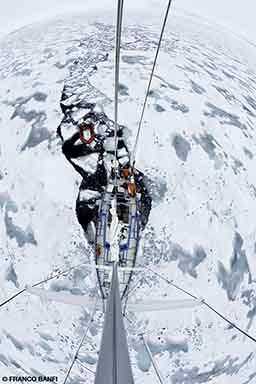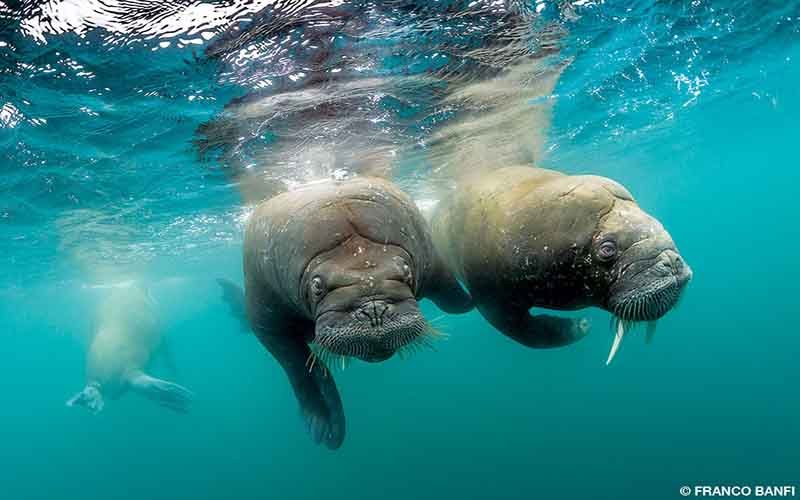Almost all walruses live within or near the Arctic Circle. The lands, seas and ice on which they dwell are unique, important and characterized by contrasts.
Among the places these animals are found is the Svalbard archipelago, Norwegian islands in the Arctic Ocean. Svalbard, which lies between 74 degrees and 81 degrees north latitude, is the second northernmost inhabited land in the world (after the Canadian island of Ellesmere). More than 800 miles north of the Arctic Circle and not far from the North Pole, Svalbard is home to spectacular wilderness and wildlife, both topside and underwater.

Nature determines everything in the North, and walruses are well suited to their ecological niche. One of the largest pinnipeds, walruses can weigh more than 3,000 pounds. But their tusks, blubber and muscle may not be enough to see them through the human-caused changes to their environment. Climate warming means much less Arctic ice now and absent ice packs during more of the year than before. Walruses and other Arctic mammals in general are highly vulnerable to these effects of climate warming due to their total connectedness with sea ice for all essential aspects of their lives: traveling, hunting, feeding and, most important of all, breeding.
When sea ice disappears, these whiskered, bellowing mammals spend more time on land and forage closer to shore instead of in their rich feeding grounds at sea. Females also give birth on land, which puts babies at risk of trampling by adults. Finally, walruses spend more time traveling at sea, which puts them at risk of encountering other human activities.
The three subspecies of walrus are the Atlantic walrus, the Pacific walrus and the Laptev walrus. Humans have exploited walruses, like many other species, for centuries. Hunters devastated the Atlantic subspecies between 1750 and 1950, when walrus blubber was precious for use as lubricating oil, their thick hide was used for leather, and their tusks were a source of ivory. Though hunting has mostly been banned now, walrus numbers have recovered very slowly because females are not sexually mature until they are 6 to 9 years old, and mature females bear just one calf every three years.

walruses and polar bears.
Besides humans, the only predators of walruses are orcas and polar bears, which are functionally obligate carnivores and are physiologically dependent on consuming the blubbery bodies of marine mammals. Other foods simply cannot meet their energy needs over the long run. Polar bears prefer to prey on seals, but when seals are unavailable they will seek other nourishment. Walruses’ bodies are full of nutritive blubber, but they are difficult to hunt because they are powerful, suspicious, have thick skin and live in large colonies. When assaulted by a polar bear, all members of the colony mobilize and begin moving as one, which can disorient the polar bear. The bear needs to minimize the risks and maximize the result of each attack if it is to meet its caloric needs in the context of its evolving habitat. But sometimes the resulting chaos causes some old or very young walruses to be injured, and in these rare occasions they become easy prey to fill the starved bear’s belly.
Walruses eat sea worms, mussels and clams, which they suck from the seafloor. They find food with the help of up to 700 mystacial vibrissae that cover their faces; extremely sensitive tactile organs, the vibrissae are a broad mat of stiff bristles around the walruses’ tusks that help them differentiate shapes. Walruses’ eyesight is not as sharp as that of other pinnipeds because acute vision is not necessary for their survival since they feed on sedentary bottom-dwelling animals. After foraging, they usually congregate on land to rest and digest, yawning and stretching their whiskers with hollow grunts. Like whales, they blow water when they surface after dives, but they use both nostrils and their mouths to exhale.

Walrus haulouts are like swarms in slow motion. The animals are gregarious by nature and spend prolonged periods in their large colonies in quiet stillness until suddenly chaos breaks out, usually caused by one walrus trying to shift position and in doing so jostling others nearby. There is a lot of grunting and bellowing, a little tusk jabbing and lots of blubber slapping. Then after a short while everything settles down again until the next chaos.


as the Arctic warms.
Some individuals are very curious. We did not expect the walruses to be so inquisitive, and we were surprised when they swam toward us in shallow water without warning. Being charged by a wild animal weighing nearly a ton is a memorable experience. Each individual seemed to have its own personality; some were so shy we were unable to approach and take pictures.
Although walruses are clumsy and slow moving on land, they undergo an astonishing transformation in the water, becoming dynamic and graceful. Like all Arctic animals, their ability to adapt to a changing environment will be important in the years ahead.
| © Alert Diver — Q1 2018 |